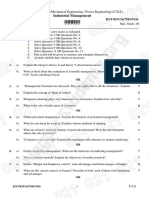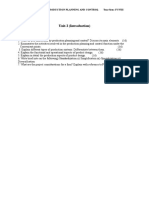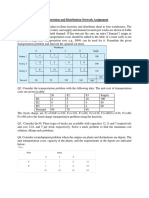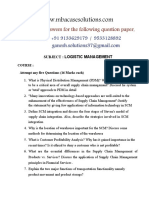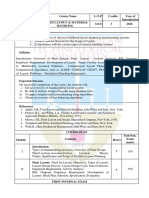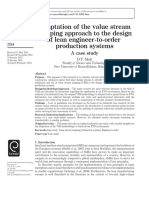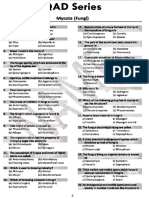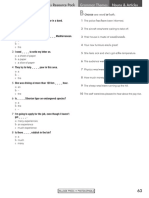Professional Documents
Culture Documents
Application of Operation Research in Steel Industry
Copyright
Available Formats
Share this document
Did you find this document useful?
Is this content inappropriate?
Report this DocumentCopyright:
Available Formats
Application of Operation Research in Steel Industry
Copyright:
Available Formats
Volume 7, Issue 10, October – 2022 International Journal of Innovative Science and Research Technology
ISSN No:-2456-2165
Application of Operation Research in Steel Industry
Soumya Agrawal, Hansika Sachdeva, Abhinav Sheoran, Kirti Jindal, Neeransh Goel
School of Commerce, SVKM NMIMS Bengaluru, India
Abstract:- In the paper, we have discussed the steel industries is to find and maintain the best balance of raw
Application of Operation Research in the steel industry, material inventory, minimising the cost, which are solved by
and how its tools have helped the industry in tackling using the inventory management strategy – Economic Order
different kind of problems by creating implemental Quantity (safety stock and safety lead time), Decision Model
solutions to complex business challenges. Steel industry is and Lagrangian Relaxation.
playing an important role in Indian economy as it can
steer India towards $ 5 trillion economy by 2025, as per Y. Maheswari stated that Inventory Management is an
the EY-CII report, which makes the development of the important area for an industry like Steel. Different techniques
industry even more important. We have shown the are there to maintain a fair inventory level depending on the
existing use of Operation Research in the industry to various factors such as supply, demand and production
exhibit its potential. capacity. Operation research has been done using tools like
ABC Analysis and EOQ Analysis to have better management.
Keywords:- ABC Analysis, EOQ Analysis, Decision Model,
Lagrangian Relaxation, Transportation Model, Network According to Dharmendra Yadav, the author, concludes
Analysis, LPP, Monolithic Model, Integer Programming, Six that a major problem faced by the industry is high
Sigma, Decision Making. transportation cost of the raw materials, which can be solved
using transportation model- North West Corner method,
I. INTRODUCTION Least Cost method, Vogel’s method.
Steel industry, the business of processing iron ore into According to R.T. Askerbeyli Transportation Cost is
steel and turning that metal into final product. The whole one of the major problem in steel industry to solve this
process revolves around different points including problem he suggest a tool called Transportation Model in
manufacturers, suppliers, transporters, warehouses, retailers which VAM METHOD.
and customers where operation research tools are used to
have efficient and effective industry where the costs are According to, Atanu Das, with non-linear objective
minimized and profits are maximized. functions and linear constraints, a fixed charge capacitated
transportation problem is examined. As a result, we provide a
The challenges that confront steel industry in the age of method for solving this transportation problem together with
globalization are complex in nature, the secret in sustainable a local optimum condition for the problem. With non-linear
turnaround lies in how steel industry faces the challenges and objective functions and linear constraints, the fixed charge
develops competitive and anticipatory process. Most of the capacitated transportation problem is examined in this study.
problem can be solved by adopting and modifying their
operational management strategy. 50% or more of the jobs in According to Ville Isoherranen Production
the industry are customer service, quality assurance, Optimisation is one of the major problem in Steel Industry
production planning, scheduling, inventory management and which can be solved by Decision-Making tool which helps
logistics, in fact all other functional areas are inter-related to to optimize cost by taking corrective decision-making
these jobs where operation research and its various tools have measures which lead to cost efficiency and maintaining the
been proven to be effective. required level of production with proper resource allocation.
Our objective is to look into and analyze the various Mohammad Reza Soltany has looked into the
tools and how they are used in solving different problems productivity of steel industry in developing countries which
faced by the steel industry now-a-days. In today’s world, are not equipped with best technology, best labor. To make
Operation Research has proven to be really important with its their productivity better, Operation Research has been done
in-depth application and steel industry is yet to utilize its full where LP model is used to undertake Supply Chain
potential. Our aim is to promote the idea of having more Management in steel plant that uses blast furnace method.
research in this area.
Author, Matheo Biondi, felt the problem faced by the
II. LITERATURE REVIEW industry is the delay in production scheduling of hot rolling
mill in a steel plant and its scheduling challenges, which can
According to L.tang, one of the main problems faced by be solved using tools like Scheduling Algorithms and Mixed-
the steel industry is the exorbitant inventory cost for storing Integer Linear Programming Formulation.
the very large inventories to ensure continuity of production
of the industry. Hence, a serious subject faced by most large
IJISRT22OCT1210 www.ijisrt.com 1767
Volume 7, Issue 10, October – 2022 International Journal of Innovative Science and Research Technology
ISSN No:-2456-2165
Okwu Issac found problems in scheduling and knew altered or a new system is implemented, simulation
effective scheduling is necessary for quality control and so a techniques must be used.
solution methodology is developed which combine a model
predictive control strategy-based approach to tackle parallel III. FINDINGS AND ANALYSIS
process scheduling problem, rolling horizon approach to
allow applying Lagrangian Relaxation algorithm to solve the Inventory Management
model of the scheduling problem in a rolling fashion. The study is to look at the inventory management
procedure and to recognise the key factors that affects
Hubert Hadera highlighted production delays and over inventory management practices and explore different
the top electricity costs and took assistance from the concept approaches. Inventory management is an important area of
of a Monolithic model to find an optimal production schedule the industry. If the company fails to manage inventory, it will
of the steel making process, while satisfying complex face issues. Different inventory management techniques are
production constraints and making sure the demand of there to maintain a fair inventory level in the plant.
electricity is constantly at par with the available supply.
ABC Analysis is an OR tool that determines the value
Goutam Dutta, in his paper believes that India, being a of inventory items based on their importance to business.
developing country faces many discouragements towards its ABC ranks items based on demand, cost and risk data, and
path of economic growth, industrialization and having poor inventory mangers group items into classes. It is based on the
capacity of utilization of power plants, because of which steel assumption that a small number of inventory items may
industry is highly impacted mainly with the power crisis, generally reflect the bulk monetary worth of the total
which can be solved using the Works Planning Model from materials employed in the manufacturing process. While a
Linear Programming Models. relatively large number of items may represent a small
portion of the money value of stores used and that small
Patrick Alexander Philippe Carter, B.Eng.Mngt saw a number of items should be subject to the greatest degree of
problem of optimal classification of lots which can be tackled continuous control. ABC analysis for inventory provides
by Batch Scheduling. Scheduling include different methods better control over working capital costs. The data we get
which helps to reduce cost and allocates resource at optimal from the analysis reduces obsolete inventory and boosts the
cost and time. inventory turnover rate, or how often a business should
replace items after their sales.
Pekka Kess in his paper believes Quality Management
in steel industry is a significant part and should improve Lagrangian Relaxation is one of the most widely used
quality when needed which can be done by Six Sigma and and efficient methods used to solve large scale integer
Lean Thinking (Improvement tool). Six Sigma is a programming problems by performing constrained
recognized approach to problem-solving that employs quality optimization. For a minimisation problem, the solution to the
and statistical techniques to enhance fundamental processes. Lagrangian dual problem provides a lower bound, while each
The Lean Thinking model facilitates improvement in patient feasible solution provides an upper bond. LR introduces the
care with available resources, meaning the same things can be constraints into the main problem decomposing it into a
achieved using fewer personnel. relaxed problem, making it easier to solve. It is usually
performed by creating two groups, one in which number of
Daniel C. Merten, in his research paper has showed how raw materials is fixed and the ither where the raw material
manufacturers of steel prefer working with auxiliary groups are fixed. When the number of raw material groups is
recommendation algorithms to handle the steel making fixed, it decreases the duality gap but the number of raw
scheduling processes, however, the main issue in this scenario materials increases increasing the computation time. When
is the lack of clarity regarding the degree of complexity that the number of raw materials is fixed, the duality gap and the
is required in these algorithms and to tackle this, the author computational time increase as the number of raw material
introduces a shuffling-aided network method for evaluating groups augments.
the complexity of the selection patterns.
Decision model is used for determining the optimal
Jayant Kalagnanam’s report involves matching an order order interval and inventory level of each group of raw
book against surplus inventory as a pre-processing step materials. The objective is to minimise the total cost of
towards production planning in a large steel plant using manufacturers attributed with the raw material inventory.
geometric and quality attributes to tackle the prescribed This model uses setup costs and inventory holding cost as an
problems during all operations planning applications. objective function with some constraints related to inventory,
to get the solution.
According to Sankarshan Basu and Goutam Dutta, this
survey paper looks at various different applications of the EOQ is a classical approach designed to find the optimal
non-Optimization techniques in Operations Research used in order quantity for businesses to minimize logistics costs,
the steel industry particularly in the process of steel making warehousing space, stockouts, and overstock costs. It is the
all across the world. The most significant study, is the question, how much to order the quantity when inventory
stochastic control of the production system. In order to assure is replenished. If the firm buying raw materials, this is to
the accurate and intended output before the existing system is purchase the quantity of each replenishment and if it has to
IJISRT22OCT1210 www.ijisrt.com 1768
Volume 7, Issue 10, October – 2022 International Journal of Innovative Science and Research Technology
ISSN No:-2456-2165
plan for production run, it is how much production to MRP is another idea of this system is to have stock when
schedule. It involves carrying cost and ordering cost. needed and to have none when it is not needed. The focus is
Industry like steel gets benefitted a lot through this tool since not just to look at the reorder point for the items but on
logistics costs tends to be high here which makes it important identifying the size and timing requirements from the master
for them to keep it in check. production schedule.
Transportation Cost Supply Chain Management
Transportation is one of the fundamental challenges that Major problems faced by steel industries in developing
is commonly used to decrease transportation costs for countries majorly include severe lack of technology, low
companies with many origins and destinations while meeting productivity of labor, low potential utilization of resources
supply and demand requirements. which makes it even more important for them to minimize
their production cost and maximize their profit through
The transportation models or problems are primarily something else.
concerned with the best possible way in which raw materials
can be supplied at various factories or plants from the source Linear programming model is used to undertake the
of raw materials can be transported to a number of sides of Supply Chain Management (SCM) in steel industries that use
raw materials according to plant demand known as demand blast furnace (BF). Objective functions used in the model are
destinations. The problem of minimizing the total purchasing and providing principal raw materials (iron ore
transportation cost is generally considered as a single source and coke) for a steel company, transforming them into various
linear transportation model. types of steel products, and transporting them to different
destinations to minimize the total cost. Constraints applied to
Transportation model is used for optimization of the this model include constraints on resources, production and
cost for transportation of supply of the raw materials from the selling the steel products. Main features of the model
source to the destination by the help of the truck vehicles by consisted forming a relation among decision variables and
road. One of the most important utilization of the method of considering diversity and amount of provided ore from
solving the transportation problem to reducing or minimizing different mines, consumed coke and diversity among steel
the transportation cost of the transportation. The simple products. Since end product pricing is not in control of
algorithm method can be used to solve any linear manufacturers, if we plan supplying, manufacturing and
programming problem but this method is called laborious. distribution according to the model result, cost reduction can
The model is classified into two parts: routes of roads from be achieved.
source to the destination and vehicle condition and optimises
manpower. The model is solved using three methods: North- Effective Scheduling
west Corner, Least Cost, and Vogel’s method. Steel industry being one of the most complicated
industries as recognised production scheduling as a difficult
Due to the fixed charge, the non-linear capacitated industrial scheduling problem. Different approaches
transportation issue does not have a global optimal solution. recognise this problem differently and are there to give
This problem's intriguing feature is that there may be more positive outcomes.
solutions than there are origins plus destinations, multiplied
by one. These kinds of issues are applicable to several Okwu Issac found that when the charges and casts in
industries, trading firms, etc. scheduling are defined through lot planning, the plant has to
determine when and where (on which device) each charge
Production Optimisation should be processed at each production stage. Model-based
The decision-Making tool helped to optimize cost by predictive control (MPC) describes a set of advanced control
taking corrective decision-making measures which lead to methods, which make use of a process model to predict the
cost efficiency and maintaining the required level of future behaviour of the controlled system. Here, Rolling
production with proper resource allocation. Horizon approach handles the disturbances in the dynamic
environment and Lagrangian relaxation embedded into the
These challenges include the continuous pressure and rolling horizon strategy tackles scheduling problems. The
new demands placed by customers and the need to drive costs observation showed that it yielded significantly better result
down, to improve all operations for better agility, and to with good improvement compared to a different method in
manage the company in meeting its needs. Operation Research, passive adjustment method.
Production planning is the most common approach for Scheduling Algorithm helps in processing efficient,
solving the production optimization challenge is the “push effective and feasible algorithms on the hot rolling mills
production” approach in which demand is predicted and which majorly consists of a set of production campaigns or as
goods are produced before customer order and the second called rolling programs which comprise of a finite number of
approach is pull production in which the manufacturing of slabs. It includes majorly two steps: building a rolling
products or parts is to meet only the actual immediate program and sequencing the built rolling program. To
demand. optimally compose the program, the minimal cost flow is
used. The challenge is formulated as a MILP problem with
due date and production mix limitations. Since orders might
IJISRT22OCT1210 www.ijisrt.com 1769
Volume 7, Issue 10, October – 2022 International Journal of Innovative Science and Research Technology
ISSN No:-2456-2165
be delayed for several weeks, the scheduling department steel and sale able steel production and the market demand
acquires a better understanding of the order book and the and commitment for the month.
additional material required to fill gaps in the order portfolio.
A hot rolling mill production planning approach that The output of the model was the optimal production
generates optimum hot rolling programmes and schedules. targets of different mills, steel melting shops and blast
The optimum manufacturing schedule is established by furnaces. The model was run successively with a objective of
building and sequencing hot rolling programmes. maximisation of production and contribution to the same
profit maximization objective and the difference in the value
Harjunkoski and Grossmann (2001) also introduced the of objective was observed.
general precedence scheduling model for the stainless-steel
plant. Harjunkoski and Sand (2008) introduced more flexible As the availability of the power is decreased, the
formulation having stages and multiple machines. The processors go out of the optimal product mix. The guiding
scheduling part of the model uses assignment and precedence principle is that if processor goes out of the optimal product
binaries following equations from Hadera and Harjunkoski mix first, it should be the first processor to be shut down.
(2013). The scheduling model is based on the precedence Henceforth, the model changed the relative importance of
variables and assignment variables that suggests which of the different processors in the case of a power crisis.
parallel machines on each stage shall process a given heat.
This production schedule also helps in defining the demand The proposed formulation describes a power intensive
of electricity so that the supply can be monitored side by side steel making process that produces a set of products on a
specified set of units, while also satisfying various
Power Crisis operational constraints. The plant is assumed to deliver a
Industry like steel needs huge amount of energy, which fixed number of products that are already known. The power
makes it difficult if the industry is working in a developing consumption is both unit and product specific. Electricity
economy. A developing economy tends to have poor purchase includes different options and is subject to hourly
utilization of power plants and fluctuations in power supply price-variations as well. The optimization should determine
happens generally, which makes it important for steel the optimal amounts to be transferred to/from the electricity
industry to give its best power management as possible and sources at any given time interval. (Fig:1: Optimization of
here, operation research comes into picture. steel production scheduling with complex time-sensitive
electricity cost; Hubert Hadera). However, it must be kept in
The product mix part of the model called the ‘Works mind the distribution of the costs among the elements of the
Planning Model’ was implemented by running the linear objective function might differ.
programming model at the targeted level of hot metal, liquid
Fig 1:- Optimization of steel production scheduling with complex time-sensitive electricity cost; Hubert Hadera
Classification of Lots demand patterns, changeovers, resource constraints, time
Scheduling includes different methods which help to constraints, costs, and degree of uncertainty. (Fig:2: Planning
reduce cost and allocates resource at optimal cost and time. and Scheduling Optimization in Integrated Steel Production;
The author describes 13 classifications of batch scheduling Patrick Alexander Philippe Carter).
problems. Any one particular problem can have any
combination of these thirteen classifications. The Quality Management
classifications include process topology, equipment Six Sigma is a recognized approach to problem-solving
assignment, equipment connectivity, inventory storage that employs quality and statistical techniques to enhance
policy, material transfer, batch size, batch processing time, fundamental processes. Six Sigma is now universally
IJISRT22OCT1210 www.ijisrt.com 1770
Volume 7, Issue 10, October – 2022 International Journal of Innovative Science and Research Technology
ISSN No:-2456-2165
recognized as a highly effective method for eliminating flaws Basic Procedure Planning
in a business's quality system. A set of statistical tools used in The objective is to make use of O.R techniques like the
quality management to provide a framework for process shuffling-aided network to evaluate the complexity of the
improvement is known as Six Sigma which has a great selection patterns established by a human expert during the
contribution to the steel industry. steel manufacturing process.
The Lean Thinking model is a process to facilitate The significance of various planning parameters in the
improvement in patient care with existing resources, meaning context of steel production planning have been determined by
the same things can be achieved using fewer people which applying a mixture of association rules and complex network
will impact the steel industry positively. methods. Our outcomes largely coincide with common
knowledge about the interplay of different chemistry-related
factors – with the exception that, in our dataset, elements
except carbon are largely disregarded in the manual selection
process. Our findings contradicts the existing knowledge
about steel production planning constraints, as the exact
chemical composition of consecutive steel grades technically
affects the steel quality.
Our results facilitate steel production planning by
explaining which planning goals or constraints cannot be
relaxed if the schedule preparation appears infeasible.
Consequently, if a human expert planner is absent, less
experienced planners could benefit from our work and build
on the expert planner’s know-how. On top of that, our method
helps in any situation where an order suggestion algorithm
has to be configured based on implicit selection criteria that
derive from fundamental technological production principles.
We advocate for a good focus on network-aided planning and
scheduling methods as they provide an intuitive
representation of the problem circumstances.
Production Planning
The objective is to tackle the potential occurrences of
unwanted production of surplus inventory of steel using O.R
concepts like- Integer programming to provide an instant
analysis comparing the performance of the provided heuristic
solutions against optimal solutions. This inventory
management problem can arise in certain situations like-
when orders placed are cancelled at the last minute or when
quality of acquired products is not up to standard.
The order book has a list of orders from different
customers. Each order has a target weight- (Ot) that needs to
be delivered, along with a target weight that specifies the
minimum (Omin) and maximum weight (Omax) acceptable
at delivery as well. Over and above the total weight (per
order), there are additional restrictions regarding the size and
number of units on the basis of which the order can be
factorized at delivery.
In the whole process, minimum and maximum weight
for the entire process is specified such that, the produced units
need to be within the maximum- minimum limit along with
the weight intervals.
To fulfil an order, the production units size and
quantities need to be specified such that- Minimum
production weight >= Specified production size x Specified
production quantity <= Maximum production weight.
Fig 2:- Planning and Scheduling Optimization in Integrated
Steel Production; Patrick Alexander Philippe Carter
IJISRT22OCT1210 www.ijisrt.com 1771
Volume 7, Issue 10, October – 2022 International Journal of Innovative Science and Research Technology
ISSN No:-2456-2165
The solutions described here have been deployed in a Steel industry which has been considered in different
steel plant and are now used in daily mill operations. The papers didn’t include modern steel plants which might be
surplus inventory matching problem requires that we using some different operation research tools to solve
maximize the total weight of applied orders while minimizing other problems.
the unused portion of the applied slabs, subject to the Even in the areas covered here, there is a narrow choice
prescribed constraints. of topics and uncritical use of existing methodologies.
The review shows that OR studies in developing countries
Tackling Queues have not always addressed the specific problem
Queues are inherent in all multistage-manufacturing environment of the developing economies with respect to
systems. Queuing models have also been used to perform issues of equity, management, technology, distribution
capacity calculations for various sections of a steel plant. All and infra-structure. Even in the areas covered there is a
systems for multistage manufacturing have queues by nature. narrow choice of topics and uncritical use of existing
They mostly happen in the primary mills and finishing mills. methodologies.
They come to the conclusion that this issue is much
diminished if the infrastructure and machinery of steel plants REFERENCES
and primary rolling mills are arranged in a direct line.
[1]. L Tang, (2006). Raw material inventory solution in iron
The steel industry is no different when it comes to the and steel industry using Lagrangian Relaxation.
importance of simulation, especially given the high start-up [2]. Y. Maheswari, (2020). Inventory management pattern
costs and lengthy development times associated with putting of steel industry in India.
up a plant or even changing the configuration of an existing [3]. Dharmendra Yadav, (2017). A Case Study on the
facility. To assure the accurate and intended output before the Optimization of the Transportation Cost for Raipur steel
existing system is altered or a new system is implemented, and thermal power plant.
simulation techniques must be used. [4]. R.T. Askerbeyli, (2020). Study of transportation
problem of Iron and steel industry in Turkey based on
IV. CONCLUSION linear programming, VAM and MODI methods.
[5]. Atanu Das, (2013). Fixed charge capacitated non- linear
The research helped us in knowing the importance and transportation problem.
use of Operation Research in Steel Industry. The application [6]. Ville Isoherranen, (2016). Production planning
proved that Operation Research can be used to optimize most optimisation and challenges in steel production: SSAB
of the work in steel industry. We looked at how Supply chain process review.
management was solved by Linear Programming Model; [7]. Mohammad Reza Soltany, (2012). Productivity
Inventory Management solved through ABC Analysis, EOQ improvement in a steel industry using supply chain
Analysis, Decision Model and Lagrangian Relaxation Model; management technique.
Production Optimization using Decision Making; Optimal [8]. Matheo Biondi, (2011). Production optimization and
classification of lots using Batch Scheduling; Quality scheduling in a steel plant: hot rolling mill.
management using Six Sigma and Lean thinking; [9]. Okwu Issac, (2014). Development of a quality control
Transportation cost using Transportation model; Effective programme for steel production: a case study.
Scheduling using tools like Model Predictive Control and [10]. Hubert Hadera, (2015). Optimization of steel production
Lagrangian Relaxation, etc. and Power crisis using Works scheduling with complex time- sensitive electricity cost.
Planning Model. All these OR tools helped us in knowing [11]. Goutam Dutta, (2003). A Linear Programming Model
how it minimized the cost and maximized the profits. for Distribution of Electrical Energy in a Steel Plant.
[12]. Patrick Alexander Philippe Carter, (2015). Planning and
By using computational techniques, artificial scheduling optimisation in integrated steel production.
intelligence (AI) is the study of mental processes. The [13]. Daniel C. Merten, (2021). A network analysis of
significant advancements in information systems technology decision strategies of human experts in steel
have made really useful applications conceivable. One of the manufacturing.
most encouraging advancements to date originated in the steel [14]. Jayant Kalagnanam, (1999). Inventory Matching
sector, where operator guidance for the intricate primary end Problems in the Steel Industry.
processes has been the most common application area. AI is [15]. Sankarshan Bas, (2006). A survey of the non-
anticipated to carry out the following fundamental tasks: optimisation techniques used in an integrated steel plant.
Knowledge visualisation. search tactics. planning, deduction, [16]. Subhash Datta, (1994). Applications of operational
heuristics, and strategic reasoning. Applications in each of the research in industry and industrialization in the
phases of integrated steel are described in this section. developing countries: A review
V. LIMITATIONS
The studies, conclusions must be seen in the light of
following limitations
The data is only taken from existing research paper and
no primary data collection has been done.
IJISRT22OCT1210 www.ijisrt.com 1772
You might also like
- Application of Operation Research in IndustryDocument19 pagesApplication of Operation Research in IndustrySaurabh RinkuNo ratings yet
- 1898 Ford Operations ManagementDocument8 pages1898 Ford Operations ManagementSanthoshAnvekarNo ratings yet
- Decision Analytics Case StudyDocument33 pagesDecision Analytics Case StudyAmmar Masood KhanNo ratings yet
- Operations ManagementDocument254 pagesOperations Managementdaphne.magtibayNo ratings yet
- Process Management: ISBN 978-953-307-085-8Document356 pagesProcess Management: ISBN 978-953-307-085-8RAUL EDUARDO GUTIERREZ COITIÑONo ratings yet
- Authors BookDocument176 pagesAuthors BookOliwiaNo ratings yet
- PRA Final ReportDocument99 pagesPRA Final ReportAvinash SharmaNo ratings yet
- Industrial Management: B.E. Eighth Semester (Mechanical Engineering / Power Engineering) (C.B.S.)Document2 pagesIndustrial Management: B.E. Eighth Semester (Mechanical Engineering / Power Engineering) (C.B.S.)SylvesterNo ratings yet
- Linear Programming ProjectDocument5 pagesLinear Programming Projectapi-267005931No ratings yet
- VTU Syllabus for Operation Research CourseDocument3 pagesVTU Syllabus for Operation Research CourseAbhilash Narayana0% (3)
- Inventory ManagementDABMDocument60 pagesInventory ManagementDABMbhavyaNo ratings yet
- Bhel JitDocument4 pagesBhel Jitswaroopce100% (2)
- Operations Research - An IntroductionDocument14 pagesOperations Research - An IntroductionMahesh KumarNo ratings yet
- M.A./M.Sc. APPLIED OPERATIONAL RESEARCH SCHEME & COURSE CONTENTSDocument22 pagesM.A./M.Sc. APPLIED OPERATIONAL RESEARCH SCHEME & COURSE CONTENTSMajor NkitaNo ratings yet
- Production and Operations ManagementDocument1 pageProduction and Operations ManagementYash GargNo ratings yet
- SOLVERDocument55 pagesSOLVERRichárd FráterNo ratings yet
- Managerial EconomicsDocument3 pagesManagerial EconomicsWajahat AliNo ratings yet
- SCHEDULINGDocument29 pagesSCHEDULINGkishoreNo ratings yet
- Mee1016 Lean Enterprises and New Manufacturing Technology TH 1.0 37 Mee1016Document3 pagesMee1016 Lean Enterprises and New Manufacturing Technology TH 1.0 37 Mee1016jojo pantherNo ratings yet
- Mba 801 Production and Operations Management PDFDocument577 pagesMba 801 Production and Operations Management PDFAdeniyi Adedolapo OLanrewajuNo ratings yet
- Exercise Book Level 3 - Update 2023 FULLDocument62 pagesExercise Book Level 3 - Update 2023 FULLCrazzyguy ForuNo ratings yet
- Operations Management AssignmentDocument7 pagesOperations Management AssignmentkritiwNo ratings yet
- Introduction To Materials Management BookDocument2 pagesIntroduction To Materials Management Bookka5227No ratings yet
- Question-Bank PPC MK 16marksDocument5 pagesQuestion-Bank PPC MK 16marksKannan MuthusamyNo ratings yet
- ch07 Operation Management Roberta Russell & Bernard W. TaylorDocument47 pagesch07 Operation Management Roberta Russell & Bernard W. TaylorkiruthigNo ratings yet
- MSTC Final Exam 2017Document13 pagesMSTC Final Exam 2017Elis KomariahNo ratings yet
- Accounting For ManagersDocument2 pagesAccounting For ManagersDreamtech Press33% (3)
- Operations Research: OxfordDocument7 pagesOperations Research: OxfordmadhavNo ratings yet
- Lean Application at LantechDocument2 pagesLean Application at Lantechehadjulaeha100% (1)
- Syllabus - Lean and Agile ManufacturingDocument2 pagesSyllabus - Lean and Agile ManufacturingjvanandhNo ratings yet
- Optimal Staffing LPDocument32 pagesOptimal Staffing LPcarlos fernandezNo ratings yet
- Transportation and Distribution Network AssignmentDocument3 pagesTransportation and Distribution Network AssignmentMadhurima BhandariNo ratings yet
- Md. Sanuwar Rashid's Research on Product Specific Sourcing StrategiesDocument12 pagesMd. Sanuwar Rashid's Research on Product Specific Sourcing StrategiesSanuwar RashidNo ratings yet
- Mine schedule optimization and operational realitiesDocument9 pagesMine schedule optimization and operational realitiesMohamed AwadNo ratings yet
- ToyotaDocument7 pagesToyotaHang NadimNo ratings yet
- Logistics Problems and SolutionsDocument11 pagesLogistics Problems and SolutionsSailpoint CourseNo ratings yet
- Applications and Solutions of Linear Programming Session 1Document19 pagesApplications and Solutions of Linear Programming Session 1Simran KaurNo ratings yet
- Forecasting techniques and demand dataDocument29 pagesForecasting techniques and demand dataBryan Seow0% (1)
- Chapter 12: Decision-Support Systems For Supply Chain ManagementDocument21 pagesChapter 12: Decision-Support Systems For Supply Chain ManagementpravanthbabuNo ratings yet
- Scheduling Chapter 16 Discussion Questions and ProblemsDocument32 pagesScheduling Chapter 16 Discussion Questions and ProblemsDiego Andres Vasquez50% (2)
- Linear Programming Graphical MethodDocument7 pagesLinear Programming Graphical MethodDevkaran LodhiNo ratings yet
- Milk Run ToyotaDocument6 pagesMilk Run ToyotaAchraf adenasNo ratings yet
- Project Report ON Inventory Management at Tata SteelDocument17 pagesProject Report ON Inventory Management at Tata SteelArun Kumar SatapathyNo ratings yet
- Martin Christopher 4 PDFDocument11 pagesMartin Christopher 4 PDFVangelis Rodopoulos100% (1)
- Or Problems For LINGO ExerciseDocument10 pagesOr Problems For LINGO ExerciseVisakh RadhakrishnanNo ratings yet
- IE368 Facilties Layout and Material Handling PDFDocument2 pagesIE368 Facilties Layout and Material Handling PDFloshidhNo ratings yet
- Anylogistix ALX TrainingDocument273 pagesAnylogistix ALX Trainingdesp100% (1)
- Lean Accounting, Costs of Quality & Target Costing ExplainedDocument47 pagesLean Accounting, Costs of Quality & Target Costing ExplainedrikiNo ratings yet
- 12mba32 Om NotesDocument68 pages12mba32 Om NotessanthoshNo ratings yet
- Triaxial Stress State: (+ve Sense Shown)Document18 pagesTriaxial Stress State: (+ve Sense Shown)sqaiba_gNo ratings yet
- Operations Management FundamentalsDocument129 pagesOperations Management FundamentalsSai Charan RajNo ratings yet
- Evolution OSCMDocument1 pageEvolution OSCMsanzitNo ratings yet
- Heizer Om10 Ch05Document28 pagesHeizer Om10 Ch05Nijat Kamil100% (1)
- Rapid Modeling Solutions:: Introduction To Simulation and SimioDocument130 pagesRapid Modeling Solutions:: Introduction To Simulation and SimioCarlos TorresNo ratings yet
- Application of Operations Research in Steel IndustryDocument7 pagesApplication of Operations Research in Steel IndustryInternational Journal of Innovative Science and Research TechnologyNo ratings yet
- Adaptation of The Value Stream Mapping Approach To The Design of Lean Engineer-To-Order Production SystemsDocument18 pagesAdaptation of The Value Stream Mapping Approach To The Design of Lean Engineer-To-Order Production SystemsLuis AlbertoNo ratings yet
- 8231-Article Text-19682-1-10-20190204Document10 pages8231-Article Text-19682-1-10-20190204rahul sharmaNo ratings yet
- Optimization of Raw Material Cost: A Case of Valve Manufacturing IndustryDocument18 pagesOptimization of Raw Material Cost: A Case of Valve Manufacturing IndustryAshwin KumarNo ratings yet
- Thesis On Manufacturing IndustryDocument6 pagesThesis On Manufacturing IndustryHelpMeWriteAPaperMurfreesboro100% (1)
- A Review of Rolling System Design Optimisation PDFDocument17 pagesA Review of Rolling System Design Optimisation PDFMohammedNo ratings yet
- Diabetic Retinopathy Stage Detection Using CNN and Inception V3Document9 pagesDiabetic Retinopathy Stage Detection Using CNN and Inception V3International Journal of Innovative Science and Research TechnologyNo ratings yet
- Exploring the Molecular Docking Interactions between the Polyherbal Formulation Ibadhychooranam and Human Aldose Reductase Enzyme as a Novel Approach for Investigating its Potential Efficacy in Management of CataractDocument7 pagesExploring the Molecular Docking Interactions between the Polyherbal Formulation Ibadhychooranam and Human Aldose Reductase Enzyme as a Novel Approach for Investigating its Potential Efficacy in Management of CataractInternational Journal of Innovative Science and Research TechnologyNo ratings yet
- Investigating Factors Influencing Employee Absenteeism: A Case Study of Secondary Schools in MuscatDocument16 pagesInvestigating Factors Influencing Employee Absenteeism: A Case Study of Secondary Schools in MuscatInternational Journal of Innovative Science and Research TechnologyNo ratings yet
- An Analysis on Mental Health Issues among IndividualsDocument6 pagesAn Analysis on Mental Health Issues among IndividualsInternational Journal of Innovative Science and Research TechnologyNo ratings yet
- Harnessing Open Innovation for Translating Global Languages into Indian LanuagesDocument7 pagesHarnessing Open Innovation for Translating Global Languages into Indian LanuagesInternational Journal of Innovative Science and Research TechnologyNo ratings yet
- The Utilization of Date Palm (Phoenix dactylifera) Leaf Fiber as a Main Component in Making an Improvised Water FilterDocument11 pagesThe Utilization of Date Palm (Phoenix dactylifera) Leaf Fiber as a Main Component in Making an Improvised Water FilterInternational Journal of Innovative Science and Research TechnologyNo ratings yet
- Advancing Healthcare Predictions: Harnessing Machine Learning for Accurate Health Index PrognosisDocument8 pagesAdvancing Healthcare Predictions: Harnessing Machine Learning for Accurate Health Index PrognosisInternational Journal of Innovative Science and Research TechnologyNo ratings yet
- The Relationship between Teacher Reflective Practice and Students Engagement in the Public Elementary SchoolDocument31 pagesThe Relationship between Teacher Reflective Practice and Students Engagement in the Public Elementary SchoolInternational Journal of Innovative Science and Research TechnologyNo ratings yet
- The Making of Object Recognition Eyeglasses for the Visually Impaired using Image AIDocument6 pagesThe Making of Object Recognition Eyeglasses for the Visually Impaired using Image AIInternational Journal of Innovative Science and Research TechnologyNo ratings yet
- Design, Development and Evaluation of Methi-Shikakai Herbal ShampooDocument8 pagesDesign, Development and Evaluation of Methi-Shikakai Herbal ShampooInternational Journal of Innovative Science and Research Technology100% (3)
- Dense Wavelength Division Multiplexing (DWDM) in IT Networks: A Leap Beyond Synchronous Digital Hierarchy (SDH)Document2 pagesDense Wavelength Division Multiplexing (DWDM) in IT Networks: A Leap Beyond Synchronous Digital Hierarchy (SDH)International Journal of Innovative Science and Research TechnologyNo ratings yet
- Terracing as an Old-Style Scheme of Soil Water Preservation in Djingliya-Mandara Mountains- CameroonDocument14 pagesTerracing as an Old-Style Scheme of Soil Water Preservation in Djingliya-Mandara Mountains- CameroonInternational Journal of Innovative Science and Research TechnologyNo ratings yet
- The Impact of Digital Marketing Dimensions on Customer SatisfactionDocument6 pagesThe Impact of Digital Marketing Dimensions on Customer SatisfactionInternational Journal of Innovative Science and Research TechnologyNo ratings yet
- Formulation and Evaluation of Poly Herbal Body ScrubDocument6 pagesFormulation and Evaluation of Poly Herbal Body ScrubInternational Journal of Innovative Science and Research TechnologyNo ratings yet
- Electro-Optics Properties of Intact Cocoa Beans based on Near Infrared TechnologyDocument7 pagesElectro-Optics Properties of Intact Cocoa Beans based on Near Infrared TechnologyInternational Journal of Innovative Science and Research TechnologyNo ratings yet
- Comparatively Design and Analyze Elevated Rectangular Water Reservoir with and without Bracing for Different Stagging HeightDocument4 pagesComparatively Design and Analyze Elevated Rectangular Water Reservoir with and without Bracing for Different Stagging HeightInternational Journal of Innovative Science and Research TechnologyNo ratings yet
- Auto Encoder Driven Hybrid Pipelines for Image Deblurring using NAFNETDocument6 pagesAuto Encoder Driven Hybrid Pipelines for Image Deblurring using NAFNETInternational Journal of Innovative Science and Research TechnologyNo ratings yet
- Review of Biomechanics in Footwear Design and Development: An Exploration of Key Concepts and InnovationsDocument5 pagesReview of Biomechanics in Footwear Design and Development: An Exploration of Key Concepts and InnovationsInternational Journal of Innovative Science and Research TechnologyNo ratings yet
- A Survey of the Plastic Waste used in Paving BlocksDocument4 pagesA Survey of the Plastic Waste used in Paving BlocksInternational Journal of Innovative Science and Research TechnologyNo ratings yet
- Hepatic Portovenous Gas in a Young MaleDocument2 pagesHepatic Portovenous Gas in a Young MaleInternational Journal of Innovative Science and Research TechnologyNo ratings yet
- Explorning the Role of Machine Learning in Enhancing Cloud SecurityDocument5 pagesExplorning the Role of Machine Learning in Enhancing Cloud SecurityInternational Journal of Innovative Science and Research TechnologyNo ratings yet
- Cyberbullying: Legal and Ethical Implications, Challenges and Opportunities for Policy DevelopmentDocument7 pagesCyberbullying: Legal and Ethical Implications, Challenges and Opportunities for Policy DevelopmentInternational Journal of Innovative Science and Research TechnologyNo ratings yet
- Automatic Power Factor ControllerDocument4 pagesAutomatic Power Factor ControllerInternational Journal of Innovative Science and Research TechnologyNo ratings yet
- Navigating Digitalization: AHP Insights for SMEs' Strategic TransformationDocument11 pagesNavigating Digitalization: AHP Insights for SMEs' Strategic TransformationInternational Journal of Innovative Science and Research TechnologyNo ratings yet
- Studying the Situation and Proposing Some Basic Solutions to Improve Psychological Harmony Between Managerial Staff and Students of Medical Universities in Hanoi AreaDocument5 pagesStudying the Situation and Proposing Some Basic Solutions to Improve Psychological Harmony Between Managerial Staff and Students of Medical Universities in Hanoi AreaInternational Journal of Innovative Science and Research TechnologyNo ratings yet
- Mobile Distractions among Adolescents: Impact on Learning in the Aftermath of COVID-19 in IndiaDocument2 pagesMobile Distractions among Adolescents: Impact on Learning in the Aftermath of COVID-19 in IndiaInternational Journal of Innovative Science and Research TechnologyNo ratings yet
- A Review: Pink Eye Outbreak in IndiaDocument3 pagesA Review: Pink Eye Outbreak in IndiaInternational Journal of Innovative Science and Research TechnologyNo ratings yet
- Drug Dosage Control System Using Reinforcement LearningDocument8 pagesDrug Dosage Control System Using Reinforcement LearningInternational Journal of Innovative Science and Research TechnologyNo ratings yet
- The Effect of Time Variables as Predictors of Senior Secondary School Students' Mathematical Performance Department of Mathematics Education Freetown PolytechnicDocument7 pagesThe Effect of Time Variables as Predictors of Senior Secondary School Students' Mathematical Performance Department of Mathematics Education Freetown PolytechnicInternational Journal of Innovative Science and Research TechnologyNo ratings yet
- Formation of New Technology in Automated Highway System in Peripheral HighwayDocument6 pagesFormation of New Technology in Automated Highway System in Peripheral HighwayInternational Journal of Innovative Science and Research TechnologyNo ratings yet
- PETDocument4 pagesPETMaria Dolores Barrionuevo AlvarezNo ratings yet
- EM Complete NotesDocument191 pagesEM Complete NoteswsbwaqhpwpvcwuhajkNo ratings yet
- Syllabus Changes: March 2021 Version 1Document20 pagesSyllabus Changes: March 2021 Version 1Azul IrlaundeNo ratings yet
- Gabriel's Oboe String PartsDocument5 pagesGabriel's Oboe String Partshekerer50% (2)
- Method of Statement For ELV SystemDocument7 pagesMethod of Statement For ELV SystemKo ZayNo ratings yet
- Rebels - in - Frills - A - Literature - Review - On 4Document93 pagesRebels - in - Frills - A - Literature - Review - On 4mariobogarinNo ratings yet
- Reading Module 7Document10 pagesReading Module 7lawrencekailNo ratings yet
- Trauma-Informed CounselingDocument1 pageTrauma-Informed Counselingapi-492010604No ratings yet
- Compassionate Sciences - RedactedDocument184 pagesCompassionate Sciences - RedactedNew Jersey marijuana documentsNo ratings yet
- Ch-4 Stock Markets - OldDocument56 pagesCh-4 Stock Markets - OldYibeltal AssefaNo ratings yet
- National Power Corporation vs. Teresita Diato-Bernal 2Document3 pagesNational Power Corporation vs. Teresita Diato-Bernal 2mickcarpioNo ratings yet
- Bca SYNOPSISDocument31 pagesBca SYNOPSISjigyasha oarmarNo ratings yet
- ProComp 2 Service Manual SM7008P-01Document22 pagesProComp 2 Service Manual SM7008P-01cobramcNo ratings yet
- RFC Mantis II Reader Data Sheet (2005)Document2 pagesRFC Mantis II Reader Data Sheet (2005)Tim BresienNo ratings yet
- Vistara News and Tie UpDocument4 pagesVistara News and Tie UpDimple RathodNo ratings yet
- Marine Environmental ResearchDocument11 pagesMarine Environmental ResearchPierre Otoniel Carmen MunaycoNo ratings yet
- The Tibetan Weather Magic Ritual of A MoDocument13 pagesThe Tibetan Weather Magic Ritual of A MoYORDIS PCNo ratings yet
- The Structure of PoetryDocument3 pagesThe Structure of PoetryRose Razo100% (1)
- Greetings To EveryoneDocument2 pagesGreetings To EveryoneLouella MedinaNo ratings yet
- FVNL"'" - TT - ..: MycotaDocument8 pagesFVNL"'" - TT - ..: MycotaAmbesh JhaNo ratings yet
- Royalstone ReadmeDocument2 pagesRoyalstone ReadmeAdnan BrianNo ratings yet
- Manual - Nokia - AirScale - System Module - Presentation NokiaDocument29 pagesManual - Nokia - AirScale - System Module - Presentation NokiaAndres Obando100% (1)
- Geography Grade 11 ANotes and Worksheet On Topography Associated With Horozontally Layered RocksDocument13 pagesGeography Grade 11 ANotes and Worksheet On Topography Associated With Horozontally Layered RocksTheo MolotoNo ratings yet
- Group No 5 - Ultratech - Jaypee 20th Sep-1Document23 pagesGroup No 5 - Ultratech - Jaypee 20th Sep-1Snehal100% (1)
- Journeys B2 Teacher's Resource Pack: Grammar ThemesDocument2 pagesJourneys B2 Teacher's Resource Pack: Grammar ThemesMiriam SanchezNo ratings yet
- A Study On Customer Satisfaction of TVS Apache RTR 160Document11 pagesA Study On Customer Satisfaction of TVS Apache RTR 160Manajit BhowmikNo ratings yet
- Quiz Bowl QuestionsDocument8 pagesQuiz Bowl QuestionsKeenan Dave RivoNo ratings yet
- 250 - Windows ShellcodingDocument116 pages250 - Windows ShellcodingSaw GyiNo ratings yet
- Impact of MusicDocument15 pagesImpact of MusicSterling GrayNo ratings yet
- Ceramic Foam Filter PDFDocument4 pagesCeramic Foam Filter PDFPaen ZulkifliNo ratings yet







